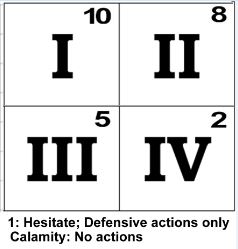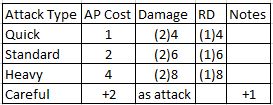Difference between revisions of "The West That Wasnt - Conflict - Action Points"
(→Spending and Taking the Counter) |
(→Advantage) |
||
| Line 88: | Line 88: | ||
During hand to hand engagements one combatant often holds an advantage against the other. Advantage can come from many sources, such as position, weapon type, weapon length or combatant skill. Advantage is tracked via the advantage counter. | During hand to hand engagements one combatant often holds an advantage against the other. Advantage can come from many sources, such as position, weapon type, weapon length or combatant skill. Advantage is tracked via the advantage counter. | ||
| − | At the beginning of any combat between two (or more) individuals, advantage is calculated. The combatant with the highest advantage may take the advantage counter. They retain the counter until either it is spent, the opponent takes it, or it is lost based on some other game rule or action. | + | At the beginning of any combat between two (or more) individuals, advantage is calculated. The combatant with the highest advantage may declare they are spending 4 AP to take the advantage counter. This declaration is made publicly, and before all other characters allocate. They retain the counter until either it is spent, the opponent takes it, or it is lost based on some other game rule or action. |
===Spending and Taking the Counter=== | ===Spending and Taking the Counter=== | ||
Revision as of 12:17, 31 March 2020
You have a Hero, and you know what the numbers mean and how the cards function. Now it is time to begin bringing the narrative to life. A good story is never easy. The protagonist finds obstacles at every turn. Overcoming these obstacles forms the basis of both the Hero and the story. Whenever a Hero is at odds with some element of the universe, there is conflict. When that conflict escalates into the physical, the Judge breaks the game down into "rounds". This may also be referred to as "action time".
Action Time
When the Judge declares action time, the sequence of game play becomes more structured. Each round is divided into four phases (I-IV). Within each phase ties are broken by Reflex die type, equipment, and other factors. After each phase is a continuous action phase (if necessary).
Initiative and Declaration
During each round of combat, the first thing that must be determined is the order of actions. Each player must determine how many APs they will use that round, and then determine when their action will resolve. Rounds are divided into four phases (I-IV), actions within each phase are considered to be virtually simultaneous.
On the character sheet is a track with the numbers 1-14. This is for initiative declaration purposes and AP tracking. Each player places their initiative token on a number within the track that will be the number of APs they will use that round. This number cannot exceed the total APs the character has available. A player that does not allocate before drawing their card is assumed to be using all available APs.
The AP tracker also lists values for 1/2 and 1/4 of the AP value, which will be explained below.
Choosing Less
Why would any player choose to spend less than their total APs? There are two reasons fewer APs may be chosen during a round. The first is that characters who use half or less of their APs receive a bonus of +1 in the Phase determination, and those who use one quarter or less receive a +2. Doing less increases the chance of going first.
The second reason is in-Phase timing. While the actions within the same Phase are considered to be virtually simultaneous, there is an order of operations, and the first tie breaker is surplus APs. The character with the most surplus APs goes first in the Phase. The second tie breaker is equipment attributes. The final tie breaker is Reflex die type. Characters who remain tied act simultaneously.
Resolving Initiative
Once the available APs for the round have been chosen, the player resolves a simple Reflex check to determine in which Phase they act. The TNs for each Phase are:
Phase I: 10
Phase II: 8
Phase III: 5
Phase IV: 2
The TN to act in the given Phase is located in the upper right corner.
Characters who generate a 1 or less hesitate and do not act that round. They still have their full defense, and may use APs for defensive maneuvers. Characters who generate a Calamity hesitate and have no APs to spend on defensive actions.
After determining the Phase, the player should place their initiative token in the appropriate box on their character sheet. This may be kept hidden until the Phase occurs, if the player wishes.
Movement
At the end of the initiative resolution characters are arranged in order from fastest to slowest. Resolving the turn is a two step process: movement and action resolution. Movement begins with the last character and proceeds in reverse order to the first.
Why does the last character go first?
By having the last character move first, we reward the quicker reactions of those at the beginning of the initiative spectrum. They are able to see and react to the movements of those who are slower. More on this later.
Resolving Movement
A character resolves their movement by spending the appropriate APs and moving their figure on the tactical map. When the player no longer wishes to pay APs, the movement ends.
Movement AP Cost
The following are AP costs for movement. Characters may change facing up to 60 degrees (one hexside) per pace of movement for free.
Drop prone: 1 AP
Stand up: 2 AP
Maneuver: 1 AP per pace (up to Dex)
Maneuver: 2 AP per pace (up to 2x Dex)
Run: 1/2 AP per pace
Duck behind cover: 1 AP
Emerge from cover: 1 AP
Change facing 60 degrees without moving: 1 AP
Change facing more than 60 degrees without moving: 2 AP
Change facing 120 degrees during a move: 1 AP
Mounts have special movement costs that depend on the quality and type, as do vehicles.
Interrupting Movement
At any time during the movement any other character may declare their intention to interrupt the movement of the character that is currently moving. They indicate this by placing their target token on the spot in the movement where they intend to target the character. If the intended action is a ranged attack, the character finishes their movement and action moves to the next character.
If, however, the faster character wishes to engage the character in melee combat, the moving character stops immediately. When the interrupter has their turn in the order they move adjacent to the token they placed.
Combat Actions
Now that we know when characters will go, what exactly will they do? What follows is a description of how to moderate the turn. Actions are resolved in order starting at the top of the initiative stack. Each action is fully resolved before moving on to the next one. Results and consequences of actions are applied immediately.
Combat actions begin with the first character in Phase I. Each action is fully resolved before moving on to the next one, and all APs are paid before resolving the action. Characters may save APs for defensive actions later in the turn.
EXAMPLE
Ranged Combat
Hand to Hand Combat
When two combatants are within one pace of one another, either may choose to initiate hand to hand combat. Hand to hand combat may be armed or unarmed, and the skills required vary with the weapon and attack types chosen. There are four attacks available:
Any attack can be a careful attack, the cost is increased by 2 AP and +1 is added to the result. The cost and bonus for careful can only be applied once per attack. Both armed and unarmed attacks use the same four standard attack types. Attacks do the damage listed plus the Damage Bonus (DB) of the character making the attack.
There are also two defensive maneuvers that may be employed: block and dodge. Block works against a single incoming attack. Multiple blocks may be performed in a turn. Dodge works versus all attacks coming from a given direction, usually 120 degrees (two hexsides, or Judge discretion).
Advantage
During hand to hand engagements one combatant often holds an advantage against the other. Advantage can come from many sources, such as position, weapon type, weapon length or combatant skill. Advantage is tracked via the advantage counter.
At the beginning of any combat between two (or more) individuals, advantage is calculated. The combatant with the highest advantage may declare they are spending 4 AP to take the advantage counter. This declaration is made publicly, and before all other characters allocate. They retain the counter until either it is spent, the opponent takes it, or it is lost based on some other game rule or action.
Spending and Taking the Counter
During any attack or test, the holder of the advantage counter may choose to spend it for +2 to cause or effect on the given test. The counter may also be spent to gain a positional advantage. If spent in this manner, the positional advantage persists until the opponent takes the counter or the position is relinquished. When spent, the counter returns to the pool and is available to be taken.
Angus Laroq confronts Hank Daggett in a back alley. Angus has a, Unarmed Combat skill of 3, while Hank has but one level. Angus begins the combat with the advantage counter. In the first round of combat, Angus declares he will perform a quick attack. Angus successfully hits a TN of 4, and declares he will spend the advantage counter to take Hank to the ground. Angus may hold this positional advantage until he chooses to relinquish it, or until Hank can escape.
Any combatant may forgo any attacks during a round and spend 2 AP to take the advantage counter if it is in the pool, or 4 AP if it is held by the opponent. If there is an advantage difference between the two combatants, the difference is applied to the cost of taking the counter.
Cyril Wellington is in a scrap with one of the vaqueros from the Laroq ranch. He is armed with a Bowie knife, but is unskilled in its use. He also holds the height advantage, being uphill from his adversary. His total advantage is 2. The vaquero also has a knife, but has one skill level with it. His total advantage is 1. If Cyril wishes to take the advantage counter, it would cost him 3 AP. If the vaquero wishes to take it, his cost would be 5.

